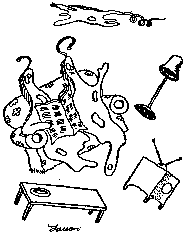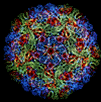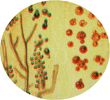| Control of Microbial Growth |

|
 |
| Readings | Presentations | Objectives | Key Terms | Multiple Choice Quizzes | Questions | Update 13/02/01 |
![]()
| Schooling, instead of
encouraging the asking of questions, too often discourages it Madeleine L’Engle |
 |
| Life in a drop of water |
I showed that B cell generate different antibody molecules by recombination bwteen multiple gene segements. I received the Noble Prize in Medicine in 1987
| Readings Control of Microbial Growth | |||
 |
Baron
Medical Microbiology chap 51 Control of viral infections and Disease |
 |
Brock
9th Ed Biology of Microorganisms Chapt 18 Microbial Growth Control |
| Tortora:
Microbiology An Introduction Chapt 7 Control of Microbial Growth |
 |
Jacquelyn
Black 4th Ed Microbiology: Principles & Explorations Chap 12 Sterilization and Disinfection |
|
| Presentation | Slides | Web Animation | Download |
| Physical Sterilization Agents | |||
| Chemical Agents | |||
| Key Terms | |||
| Aseptic | asepsis | sepsis | chlorhexidine |
| sterilization | thermal death point | HTST pasteurization | Tincture of |
| disinfection | termal death time | UHT pasteruization | iodophor |
| sanitization | Decimal reduction time | flaming | surfactant |
| bacteriostatic | D value | hot air sterilzation | emulsification |
| bacteriocidal | pasteurization | HEPA filters | quaternary ammonium compounds |
| autoclave | flash pasteurization | membrane filters | nitrosamines |
| nisin | |||
![]()
Question:
The filter paper method was used to evaluate three disinfectants.; the results were as follows
| Disinfectant | Zone of inhibition |
| Leading brand | 0 mm |
| Brand X | 5 mm |
| Major Competitor | 10 mm |
from the above results which disinfectant was the most effective? Explain
Can you determine from these results whether Brand X was bactericidal or bacteriostatic? Explain
Question :
The use dilution test was sued to evaluate two disinfectants against Salmonella choleraesuis.
The results were as follows:
| Bacterial growth after exposure | |||
| length of Exposure | Leading Brand | Brand X diluted with distilled water | Brand X diluted with tap water |
| 10 min | growth | no growth | growth |
| 20 min | growth | no growth | no growth |
| 30 min | no growth | no growth | no growth |
Which disinfectant was the most effective? explain.
Which disinfectant should be used against Staphylococcus? Explain.
The following data were obtained from ause- dilution test comparing four disinfectants against Salmonella choleraesuis
Which disinfectant is the most effective? Explain.
| Growth after exposure to: | ||||
| Dilution | Leading Brand | My choice | Brand X | Leading Competitor |
| 1:2 | no growth | growth | no growth | no growth |
| 1:4 | no growth | growth | no growth | growth |
| 1:8 | no growth | growth | growth | growth |
| 1:16 | growth | growth | growth | growth |